
Amanda Ogilvie
3rd Year, Art Education Specialization
Quebec Artists Unit Plan
Lesson Plan
By introducing Francophone artists, the unit contributed to providing an atmosphere for the class with a feeling of community, since members of the class were all Francophone, and many of them Quebec natives. The main learning objectives of this unit included the creation of a positive working space, technique development as well as the application of new skills and knowledge.
As an art educator in Quebec, I believe it is important to introduce and explore the work of artists who share our nationality. As a distinctive province in Canada, Quebec has a rich cultural identity and language, which through its history, has struggled to conserve. For an acrylic painting class I teach to adult women leisure learners, I designed a unit plan that promotes the investigation and discovery of art within our community. The theme for this unit plan is based on the various techniques of artists from Quebec. Each lesson focuses on specific Francophone artists, groups or movements and provides participants with an art historical background. To recognize and learn the techniques employed by the featured artists, students are presented different styles of painting, such as modernist abstraction. The rationale for this unit plan stems from the interests and learning histories of these students: they have been taking acrylic painting courses together for many years; have previously explored colour theory, as well as the elements and principles of design; and, I noticed, have particularly enjoyed and were motivated by learning about artists and art history. The class was comprised of all women who were either from Quebec or have lived here for most of their lives, therefore this particular subject had personal significance for them. The social objectives behind the Quebec Artists unit plan hold an important role in the success of these lessons. By introducing Francophone artists, the unit contributed to providing an atmosphere for the class with a feeling of community, since members of the class were all Francophone, and many of them Quebec natives. The main learning objectives of this unit included the creation of a positive working space, technique development as well as the application of new skills and knowledge. The unit plan is based on examining four artists, groups or movements that held a great significance in twentieth century Quebec art. The duration of each session was three hours. The first lessons looked at the Group of Seven and the Beaver Hall women, which encouraged the class to begin thinking about different techniques such as bold colour and brushstrokes. The last lesson shifted the focus to abstract painting, specifically the work of the Plasticiens, and the participants were encouraged to explore the emotional expression of painting. Students were challenged to think about what they learned about colour and different brushstrokes from the previous lessons and how they can apply this knowledge in the later lessons. As I identify in the example of one of the four lesson plans, below, in exploring the Plasticien movement, my students were asked to first use simple geometric shapes to create an abstract painting, and for their final lesson, they were invited to create an abstract series.
Example of the lesson plan: The Plasticien Movement This lesson will span over the course of two three-hour sessions.
Materials:
A) Students:
B) Educator:
C) Coordinator:
To highlight the connections between the unit plan and the Ministry of Education visual arts learning links, in my descriptive text below I have referenced their number along with an asterisk.
MEQ Links
Art Making Objectives:
Educational Objectives:
Art Form/Technique:
The category of art explored in this lesson will be abstract art. Students will create abstract art in the style of Plasticien-affiliated artist Fernand Toupin (1930-2009). They will use acrylic paint mixed with modeling paste to shape and model small crevasse-like images on their canvases. *8 & 9
Vocabulary:
Motivation:
A slide-show presentation will be shown at the beginning of this lesson to motivate the students. The presentation will include background information about Les Plasticiens artists: Louis Belzile, Jauran, Jean-Paul Jerome, and Fernand Toupin. It will include images such as Le Solitaire by Louis Belzile, Composition abstraite (no. 15) by Jauran, and Le Montagne De Silex by Jean-Paul Jerome. Images that will be shown by Fernand Toupin will include: Jeux sur neige I & II, Les Sables de fevrier and the Miniature series. Information that will also be included in the slide show will be the manifesto written by the group of artists. The educator will ask questions such as, “How are these artists the same/ different?” and “How are they different from Les Automatistes?” Exhibition catalogues and other texts will also been shown as reference material, including Jauran et les premiers plasticiens: 21 avril-22 mai 1977 (Musée d’art contemporain-Montréal), Painting on the edge: Geometric abstraction in Montreal, the 1950s, and Prisme d’yeux; manifesto. *5, 6, 7 & 9
Art Activity:
Response/Closure:
At the end of the activity, the students will group all their easels with their canvases on them. The group will sit around in front of the canvases to discuss each other’s work. They can make positive comments on what they enjoy about each others paintings, as well as how they feel about doing this type of abstract painting. Do they like using the modeling paste? Do they like the effect it creates on their painting? My experience using this lesson in the community setting was excellent; the women created beautiful final pieces and had an enjoyable experience doing so. Some of them decided that they preferred to spend their time working on one final piece, whereas others did create a series of paintings. They were pleased to learn about historical elements of the lesson, Les Plasticiens, and see images of these artists’ work. Participants were especially eager to use modeling paste, a medium that they were not familiar with. Since this was a new medium for the class, I conducted a thorough demonstration to show how modeling paste can be combined with paint and used to achieve various textures. This allowed them to feel more comfortable exploring the medium and using it when creating their art pieces. While some worked quickly and finished their paintings within the two designated sessions, others required more time; which was not a problem considering the relaxed atmosphere of the class. I found that using the theme of Quebec Artists in this lesson/unit plan to be very successful in this community setting since the participants were Francophone, Bilingual, and many of them Quebec natives. This unit allowed them to learn about influential artists in Quebec and how their art has contributed to Quebec’s significance within twentieth century art. They found the historical aspect interesting and relatable because they were familiar with Quebec’s political/social events that took place in the 20th century.
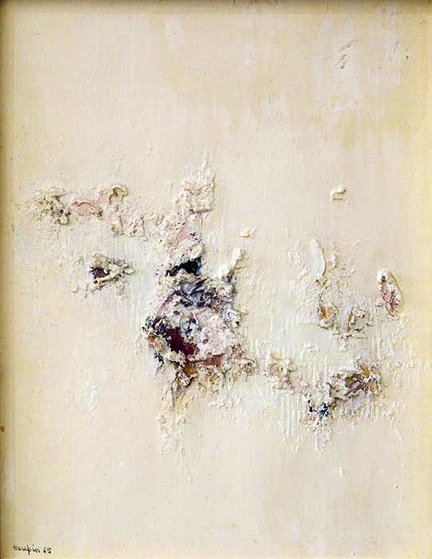
Resource list:
Davis, A. (1979). Frontiers of our dreams. Winnipeg, Canada: The Winnipeg Art Gallery.
Fernand Toupin (2012) . Retrieved from http://galeriebernard.ca/cgi/index.php?option=com_content&view=article&id=54&Itemid=50&lang=en
Fernand Toupin (n.d.). Retrieved from http://montroyalartgallery.com/english/toupin.htm
Filmer, S. (2012). Fernand Toupin’s Jeux sur neige, I & II. Retrieved from http://www.artgalleryofnovascotia.ca/en/AGNS_Halifax/about_us/collection/acquisitions/acquisitionsspotlight/Spring 2009/Jeux_sur_neige.aspx
Hume, H. D. (2010). The art teacher’s book of lists. Second Edition. San Francisco, CA: Jossey-Bass.
Patterson, J., Concordia University, & Concordia University. (2001). Painting on the edge :Geometric abstraction in montreal, the 1950s.
Québec, & Plasticiens. (1977). Jauran et les premiers plasticiens :21 avril-22 mai 1977, musée d’art contemporain-montréal. –. Montréal: le Musée.
Prisme d’yeux;manifesto (1955). Montréal: S.N.]]>
Naomi Aldrich and Christina Marie Phelps
3rd Year, Art Education Specialization
Artful Play: A community art pedagogy
Adopting artful play in the community setting is a non-threatening way to engage participation and collaboration. The format itself is open-ended, exploratory and process-emphasized, allowing for creative experimentation in authentic and often unexpected ways.
Culture and science are based on various forms of play; as such, it is of the utmost importance that play is considered as a vital component of contemporary educational practice. Play fosters “resiliency, problem solving techniques, and healthy socializing skills” (Brown, 2009, p. 8), all of which are fundamental to healthy human development and the shaping of a harmonious society. Adopting artful play in the community setting is a non-threatening way to engage participation and collaboration. The format itself is open-ended, exploratory and process-emphasized, allowing for creative experimentation in authentic and often unexpected ways. Additionally, it is a practice that encourages a breakdown of hierarchy, as instructors create playfully alongside the learners. It is our contention, based on research and practice in the community setting, that it is time for the re-visitation of playful, process-based practices that allow for fun and experimentation to enter the community art experience.
The exploration of “artful play” was initiated during our second year community teaching practicum at Tyndale St. Georges Community Centre located in Little Burgundy, historically a low-income neighborhood in south-west Montreal that is now experiencing pressures of gentrification. Inspired by the Jesse Maxwell Smith Park Project, a community park built in the fall of 2012 at Tyndale, we decided to explore the theme of community through collaborative art making practices during our after school art program. With our participants, aged five to eight, we dedicated the entire fall semester to collaborative art practices guided by the core themes of “identity” and “place” in relationship to the concept of community. Despite the initial challenge of breaking down our participants’ preconceived notion that art making is always an individual, product-oriented practice, we had a very successful and fulfilling experience. At the end of the semester we organized an on-site art show in which, parents, members of the Tyndale and Concordia Art Education communities were invited to celebrate the work of our participants.
Based on feedback and critical reflection concerning our first semester experience, we concluded that despite the success of our program, an aspect of playfulness was missing from our approach. We considered what it might be like to engage our participants in less rigidly structured lessons, focusing more on open ended, exploratory experiences. Our research turned up a wealth of theoretical and practical resources that advocated play as a critical component for healthy development, authentic learning and creativity. We were particularly drawn to the book Play: How it shapes the brain, opens the imagination, and invigorates the soul (2010) by Dr. Stewart Brown, founder of the National Institute of Play, a non-profit public benefit corporation in Carmel Valley, California. Additionally, we researched various community initiatives whose mandates were based on the philosophy of artful play. Among the initiatives that left an impression on us were, ArtPlay located in Melbourne, Australia and Playeum, The Play Museum in Singapore. Both sites have a similar structure in that they are community-based, multidisciplinary initiatives that offer a number of arts-based and artist facilitated programs for children, their families and members of the community.
With regards to pedagogy, both sites aim to foster a caring, child-centered environment that encourages active, collaborative and process-based learning through play. Indeed, we felt that the approach at these sites was very much aligned with our vision at Tyndale. Our research clarified our approach and we made the decision to attempt to explore an artful play praxis through the lens of street art interventions, community, and collaboration during the second semester. Together, we designed and implemented a program composed of two unit plans; one unit focused primarily on the exploration of selected street art techniques, the other explored a variety of street art interventions. Our aim was to engage our participants, aged nine to twelve, in collaborative, exploratory, play-based learning experiences inspired by the practices of various public/street artists and collectives. Altogether our program was composed of eight integrated lessons, three of which are highlighted below.
Open Air Art
The Open Air Art activity aimed to question the act of art-making and viewing art in public spaces, outside the confines of the traditional gallery or museum space. The group was introduced to the Situationist International, an international organization of politically engaged avant-garde artists and intellectuals mostly from Europe, formed in 1957 and active until 1972. (Ford, 2005, p. 8) Additionally, the local collective called Une Banane was presented to the participants. Their “Free for Wall” project staged art installations and interventions in public spaces (Free for Wall, 2012). For our activity, participants were provided with a variety of art materials, which included chalk, clay, stickers, erasable markers, and a number of pre-arranged gold-framed blank “canvases.” Various forms of canvases were used such as a chalkboard, whiteboard or an Etch A Sketch. Sharing materials and moving freely around the canvases, the participants were able to converse and collaborate throughout the process.
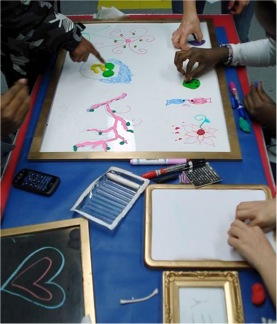
The activity questioned the nature of public art display, as the group was challenged to rethink the act of art making and as well as curating while sharing in this collaborative process. This lesson was important to the group as it helped set the tone of our Artful Play Unit. Additionally, it offered a brief art history lesson, which highlighted the hybrid movements that inspired Artful Play, such as the Dadaists, Surrealists, and the Situationists. The participants were free to play and experiment, knowing that the focus of the activity was not on the product, but instead on the invitation to create together. Through unbridled play and experimentation, the purpose of this project was to promote a sense of empowerment through collaborative art making and at the same time offer a space for each individual to express themselves freely.
No Cars Go
No Cars Go was the title of the Artful Play art intervention which introduced our participants to (Park)ing Day, “an annual open-source global event where citizens, artists and activists collaborate to temporarily transform metered parking spaces into “PARK(ing)” spaces: temporary public places,” (Parking Day, 2012). This project is part of an international movement that stems from the Reclaim the Streets umbrella, a collective with a shared ideal of community ownership of public spaces (Car-free Movement, 2014). Park(ing) Day is recognized worldwide on the third Friday in September, and addresses the issue of environmental stewardship and community spaces. Various street artists, activists, and concerned citizens set aside this day each year, where they literally take over a city streets parking spaces (often metered), for installations, interventions and performance art pieces.
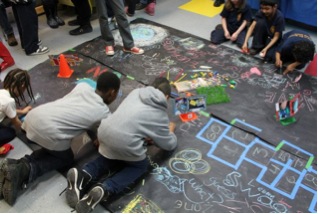
The No Cars Go activity allowed the participants to transform a mock parking space, represented by black banner paper taped to the floor and sectioned off with pylons.We used small toy cars and vehicles as paintbrushes and actual recycled car accessories as three-dimensional canvases. Colored sidewalk chalk and building toys were used to protest, as well as transform the allotted simulated parking space, into a colorful expressionistic area. The group worked collaboratively to create a whimsical installation within the confines of the dimensions of a parking space to reclaim the area for child’s play. There were no set guidelines as to what the children had to do in the area besides play. Some learners took it upon themselves to write messages with the colored chalk of protest and peace, while others built miniature playground structures. As was previously mentioned with respect to the Jesse Maxwell Smith Park Project, many participants had already witnessed firsthand the need for more green spaces and playground areas within the city. This activity reinforced this notion and further provided learners with the opportunity to reflect on their community.
Tyndale Ti(l)es
The lesson Tyndale Ti(l)es was inspired by French street artist Invader, whose tile mosaics depict characters from the classic video game Space Invaders. In addition to exploring examples of Invader’s work, we also presented examples of historical mosaics, as a way of contextualizing the long history of this technique. Other examples of contemporary street art were also introduced, including artist Jan Vormann’s project Dispatchwork, which involves the use of LEGO blocks to physically reconstruct deteriorated aspects of urban landscapes.

The playful nature of Invader’s video game inspired mosaics immediately appealed to our participants. The fact that our participants could easily relate to the imagery allowed for an interesting and authentic dialogue that helped guide and expand their ideas during the creation of their own mosaics. During the creation process, the participants sat together around a large table so that they could share materials, ideas and potentially work collaboratively. We provided them with a wide variety of materials, including, natural and glass stones, various tiles, buttons and colourful craft foam. Working on small canvases, the participants had the opportunity to explore and manipulate the materials of their choice. Encouraging participants to experiment with a variety of materials offered them a sense of creative freedom and autonomy. Having the group work together at the table promoted a constant creative dialogue and collaboration amongst the students. Indeed, one group of participants conceptualized and created a triptych based on a video game relevant to them.
Conclusion
Facilitating our combined Artful Play units gave us the chance to truly explore the hybrid art movement of play, discovery and collaboration with our participants. The program design aimed to be relevant to our participants as they were immersed in public and street art interventions on a daily basis through their exposure to advertisements, murals, tags, posters, installations, and sculptures. The participants were pleased to discover that much of the iconography from their collective free play experience, such as toys, games, activities, popular storybook characters, and comics, was considered the inspiration and mediums for many contemporary street artists. It was important to us that our lessons were relevant to the participants, while remaining open-ended, experimental, and promoting the concept of play as process acknowledging that artistic outcomes cannot be carefully prescribed (Duncum, 2009, p. 232).
Overall, the program truly met our goals. The “collaborate-and-create method” (Lawton, 2010, p. 11), mixed with the experiential nature of artful play, led to some incredible dialogue and artistic interventions from our participants throughout the year.
At the end of the winter semester, we had the opportunity to share in the success of the group by planning, with them, an art show finissage to display their actual art works as well as documentary photographs of their creation process. Invitations to the finissage went out to the families and members of Tyndale as well as to members of the community at large, including street artists and practicing community art activists. The participants were pleased to meet some of the artists whose practice and collaborative works they learned about during the semester. Many received kind words of support from their families, neighbors, younger peers from Tyndale, and Concordia University professors, further validating their experience and learning in the Artful Play program.
As art educators, we are both strong believers in the collaborative art making process, where more than one person contributes to an artwork or an idea. It is for this reason that we adopted an emergent curriculum approach in the development of the Artful Play program. Our hope is that through the promotion of artful play in the everyday, a process emphasis art and lifestyle practice, others too might explore this inclusive and thought provoking approach in their own teaching practice. After all, play allows for creativity, and creativity paves the way for innovative ideas putting forth change towards a better world.
References
ArtPlay, (n.d.). What is ArtPlay. Retrieved from http://www.melbourne.vic.gov.au/artplay/Pages/ArtPlayHome.aspx
ArtPlay Melbourne. (2012), ArtPlay engaging with artists. Video. Retrieved from http://www.youtube.com/watch?v=rlI-GZtATN0
Brown, S., & Vaughan, C. (2009). Play: How it shapes the brain, opens the imagination, and invigorates the soul. New York, NY: Avery.
Duncum, P. (2009). Toward a playful pedagogy: Popular culture and the pleasures of transgression. Studies in Art Education, 50(3), 232-244.
Ford, S. (2005). The Situationist International: A user’s guide. London: Black Dog.
Lawton, P. (2010). Hand-in-hand, building community on common ground. Art Education, 63, 6-12.
Ohio Art. (2013). Etch A Sketch. Retrieved from http://ohioart.new.cosdevx.com/brands/etch-sketch
Park(ing) Day. (2012). About park(ing) day. Retrieved from http://parkingday.org/
Playeum, The Play Museum. (n.d.). About the playeum. Retrieved from http://www.playeum.com/our-programme
Situationist International (n.d.) In Wikipedia. Retrieved from http://en.wikipedia.org/wiki/Situationist_International
World Carfree Movement. (2014). Retrieved from http://www.worldcarfree.net/
Vormann, J. (n.d.). Dispatchwork. Retrieved from http://www.janvormann.com/testbild/dispatchwork/]]>
Hailey Burke
3rd Year, Art Education Major
Modeling behavior, environment, and attitudes for success: Putting transformative theory into practice
Through reflection, I realized that the role of an art educator is to act as a facilitator by establishing an environment that both fosters the diverse needs of students and provides a clear structure for participation. I believe it is essential for their development to have youth learn, engage, make, and appreciate art.
In anticipation of entering a new community art class, teaching twelve students aged five to eleven, I began drafting lesson plans. I imagined students hard at work, attentively listening while I glossed over art history, joyfully immersed in their art making process. I dreamed that the students would naturally participate, make connections, and engage in meaningful social interactions. I created a unit plan that focused on the theme of transformations. The lessons incorporated art history and pop-cultural references. The design of my lessons included a collective brainstorming question, followed by a brief answer period to help students create ideas about their projects. The projects were focused on creating interdisciplinary artworks that used a variety of skills including spatial awareness, planning, and fine motor skills. This type of multi-faceted project planning was designed to allow students to excel in different areas of learning. As the students would invariably have different skill sets, I would encourage them to help each other during their art making. These methods sought to ensure that students would find some sense of accomplishment during the program.
Walking into the classroom on the first day, fully prepared to engage the students in a collaborative art project, full of challenges and exciting materials, I was confronted with a plethora of sighs, moans and a distinct distaste for ‘art class.’ Based on my previous experience, I thought that in order to gain support by students, I could encourage their engagement through age relevant projects, which promote responsibility towards each other in the classroom. Despite my efforts, their preconceived attitudes towards art and art making became a much larger obstacle to overcome than expected. One particular student displayed oppositional behaviour characteristics that set negative examples for the other students in the classroom. The behaviour would quickly spread, and I began to realize that it was detracting from the quality and authenticity of their art making process. This quickly became the biggest challenge during my time with this class. I began to think of possible strategies to change negative attitudes through modeling and environment.
I decided that in order to guide students towards a more positive outlook on art and art-making activities, I would attempt to foster an open atmosphere. Drawing from Richard Schechner’s theories of performance and ritual, I began to investigate the relationship between behaviour, identity, and performance. Schechner, states that “[t]he many performances in everyday life such as professional roles, gender and race roles, and shaping one’s identity are not make-believe actions […]. The performance of everyday life ‘make belief’ – create the very social realities they enact” (Schechner, 2006, p. 42). For this reason, I thought of challenging the students to think of themselves as ‘real artists’. This was done through creating portfolios, pretending to be in a gallery, modeling vocabulary, engaging in critiques, and developing serious art projects. I wanted the students to begin to think of art as a serious intellectual, cultural, and creative endeavor.
I began to implement my ‘make-belief’ modeling technique by focusing on desired language. During critiques, I would define what the students were to look at, and comment on. In order for students to have a better understanding of meaningful language I would offer the first comment. This type of structuring helped students to remain positive and use appropriate language towards their peers. Confident with the progress, I began to use this modeling as a behavior management tool during the rest of the class time as well. Lowe argues that “[t]he most common mood conducive to a positive community-art experience is comfortable and playful. There must be a safe space for interaction. A social setting that occurs as non-threatening and relaxed for participants. That space is constructed very deliberately by words and actions that set the stage.” (Lowe, 2001, p. 460)
I therefore began to moderate the environment towards an optimally positive and comfortable space for all participants. By reflecting on the role of the environment, I realized that as art educators, we need to be thoroughly conscious of the parameters we are setting for students. Whereas initially, during the art-making process, conversations would often go astray, I found asking questions about the participants’ process, intentions, choices, and feelings at different moments helped veer conversations towards a productive direction. This allowed participants to focus on their personal art-making process. Students were better able to engage in the tasks at hand and were more likely to produce creative and self-driven projects. In retrospect, I realize that although the older students started with a low interest in art and making art, what they needed was to be given opportunities to express themselves in a capacity that was comfortable to them. I think that, for some students it was difficult to leave behind their developing ‘young adult personas’ and truly engage without fear of their peers’ reproach. It was therefore truly rewarding to watch these students become engaged and creative in something they had initially been opposed to. Pacific (1998) states that “Art is or should be an agent of social change, and that everyone is an artist … There is no doubt in the minds of community artists that social change takes place – for artists and community members alike… the production of art by people who don’t define themselves as artists – is a radical, transformative act” (Pacific, 1998, p. 40)
Through reflection, I realized that the role of an art educator is to act as a facilitator by establishing an environment that both fosters the diverse needs of students and provides a clear structure for participation. I believe it is essential for their development to have youth learn, engage, make, and appreciate art. It is now my understanding that this begins with an environment that encourages growth through exploration of different modalities and ways of being. The numerous skills that students acquire through the art-making experience, that include problem solving, different ways of being, developing vocabulary, and creativity, are essential to their social development.
It is our responsibility as art educators to enable students with the opportunities that engage them in this manner. Chambers (1997) argues in favor of a postmodern outlook on the education environment. He states that through this environment, “The trends towards centralization, authoritarianism and homogenization are reversed. Reductionism, linear thinking and standard thinking give way to an inclusive holism, open-styled thinking, and diverse options and actions” (Chambers, 1997, p. 89) It is my belief, based on this rewarding personal experience, that the exploration of new ways of being and thinking can be developed through pedagogical approaches that help enable the students to be more versatile, not only in understanding but creating culture, art, and community. Through transformative experience, we can afford students in our art classes with the tools and skill-sets required for success.
References
Chambers, R. (1997). Whose reality counts: Putting the first last. London: Intermediate Technology Publications Ltd (ITP).
Lowe, S.S. (2001). The art of community transformation. Education and Urban Society, 33, 457-471.
Pacific, R. (1998). This is not a Benetton ad: The theory of community art. MIX, 23(3), 28-43.
Schechner, R. (2006). Performance studies: An introduction (2nd ed). New York, NY: Routledge.
Roxanne Leclaire and Amanda Ogilvie
3rd Year, Art Education Specialization
The digital age: Media education and at-risk youth
The main objective of media education is to develop both critical understanding as well as active participation in the learner. To become a critical observer, one has to become media literate.
Technology has become an ever-increasing component of daily life. As “digital natives” (Prensky, 2001), today’s youth are remarkably knowledgeable and comfortable with technology and new media. In order to provide relevant education to this generation, teachers should give students the opportunity to explore and experience the different facets that new media has to offer. By doing so, teachers can successfully engage and sustain the interest of learners, especially, we argue, for at-risk youth whose motivation can be difficult to maintain. Through our research findings we will discuss how at-risk youth can come together through community-based settings and initiatives with the use of technology. ‘‘At-risk youth’’ can be defined as ‘‘young people whose background places them ‘at risk’ of future offending or victimization due to environmental, social and family conditions that hinder their personal development and successful integration into the economy and society’’ (UN-HABITAT, 2003). Various types of art initiatives have been implemented in the attempt to help at-risk youth develop in a more socially positive fashion. For instance, prevention programs are designed to support this population with acquiring social, emotional, and vocational skills (Stinson, 2009, p. 10). Such programs have shown improvement in self-esteem, feelings of worth and reduced interest in committing crimes.
These prevention methods can be especially important for youth who have already committed crimes, since they are more likely to continue to be involved in self-destructive behaviour and reoffend (Stinson, 2009, p. 10). These types of initiatives have proven to be successful in juvenile detention centers by providing a community atmosphere for these youth. For example, the art program at the X Woman’s Juvenile Detention Center, in X City, has shown, proven to be particularly beneficial in aiding the young women with self-reflection and expression (2009, p. 13). Considering the increasingly important role of technology within North American society, material and methods taught in educational community initiatives must engage technology to remain pertinent to the lives of today’s youth. Many community-based initiatives have sought to respond to this emerging technological phenomenon by providing at-risk youth a setting that offers an educational media approach. This approach fosters ‘‘self-expression, creativity, critical analysis, and the development of identity and voice’’ (Castro, Darts, Grauer & Sinner, 2010, p.81) through the use of technology. The main objective of media education is therefore to develop both critical understanding as well as active participation in the learner.
To become a critical observer, one has to become media literate. Media literacy, as defined by the Association for Media Literacy (AML), is an ‘‘educational initiative that aims to increase student’s understanding and enjoyment of how the media work, how they produce meaning, how they are organized, and how the media construct reality“ (AML, 2012). Media literacy encompasses three main points, the first one being that all media are constructions. In fact, “media products are never entirely accurate reflections of the real world – even the most objective documentary filmmaker has to decide what footage to use and what to cut, … but we instinctively view [it] as direct representations of what is real” (MediaSmarts, 2013). The second point centers around the creator’s aesthetic choices to convey the desired message to the target. Aesthetic elements, such as editing, point of view, angle, lightning, movement, scale, sound, and so forth, are intentionally used to produce a desired effect (MediaSmarts, 2013). The third and last key element focuses on how each individual in the audience will interpret a visual piece differently. Factors, such as, age, gender, race and social status will affect how we view and analyze media (ibid). ‘‘Identifying these elements will help towards increased appreciation of media and how they affect audiences’’ (Roman, n.d.)
Moreover, to help youth better identify these mentioned elements of media (construction, aesthetic and interpretation), one can create activities that focus on deconstructing the media and uncovering its layers one at a time. A series of questions that revolve around initial reaction, description, analysis and interpretation, and aesthetic choices of a piece of media shown to the class can be a useful exercise. Individuals interpretations of a work will always differ; therefore, a class discussion comparing participants’ multiple points of view becomes crucial. Through the deconstruction approach, one becomes consciously aware of how the media works and how artistic choices can impact the final message of a piece. Downtown Community Television Community Center or DCTV, a New York organization, specializes in creating youth media productions useful in a deconstruction approach. Using the work of DCTV, educators may prompt learners to analyze and explore the importance of creative choices in new media. To trigger reflection, one might consider the following questions: What do and don’t you see in this short video? What is its purpose? What is the mood and ambience of the piece? What is the language being used? Based on the students’ responses, a discussion may be encouraged, investigating what they conclude about the piece and its intended message.
One can then further explore their newly acquired skills in media literacy and apply these skills hands-on by becoming their own producer of media. By becoming an active participant “students are encouraged to become creative thinkers and problem solvers as they script, story board, produce, and evaluate media for a variety of purposes and audiences…critical viewing skills [therefore] emerge naturally… as a by-product of the production process” (Grace, 2005, p.7).
New media approaches in community settings that are focused on at-risk youth have started to emerge on a global scale. For example, in New Zealand, the Auckland community started an art-based initiative called The Cheeky Darkies, a series of short films called SSDD (Same Shit Different Day) created by at-risk youth. For a year and a half, the youth worked with mentors and learned about filmmaking. Throughout this self-directed project they scripted and acted in their short film. In the end, the final products were shown at the Academy Cinema in their town and consequently it gained public recognition. This is a ‘‘good example of how a quality art outcome created by young people…can stimulate a sense of pride, achievement and recognition for youth at risk; can facilitate dialogue about the real issues’’ (Houbolt, 2010, p.49).
For artist and community educator Sarah Houbolt, art can be used as ‘‘a tool to connect with others, as a vehicle to have a voice and be heard, and as a legitimate pathway for personal development / employability’’ (2010, p.46). Engaging technology through filmmaking therefore becomes a great opportunity for at-risk youth to get back on track and reconstruct their path towards positive behaviour.
We have seen one example of how a media approach has been incorporated in New Zealand but it has also been used by a Canadian organization in Toronto focused on at risk youth called Sketch. They put a lot of emphasis on the process as at least as, important as the end product, if not more so. The youth, aged from 15-29, are invited to participate in to a variety of self-directed projects, including some involving new-media and music. In this particular workshop, the participants are introduced to emerging new art forms such as film and animation as a way to express themselves. As the organization states, ‘‘Street involved and homeless youth seek alternatives to traditional forms of education, therapy and skill building. The arts allow youth to determine their own individual pace of change’’ (SKETCH, 2013).
Today’s youth play an important role in shaping our future, therefore media literacy is one of the skills students must learn. It has therefore become crucial important for this population to be able to use, understand and produce media. At-risk youth who become media literate not only increase their chances of employment, but may also experience an increase self-esteem and confidence through self-directed projects. Rather than fearing the use of new media in educational settings, as educators, we must embrace it and use it in a way to fosters personal development and social justice.
References
Association for Media Literacy (2012). The association for media literacy. Retrieved from http://www.aml.ca/
Beaton, B., & TED-Ed (n.d.). The key to media’s hidden codes. Retrieved from http://ed.ted.com/lessons/the-key-to-media-s-hidden-codes
Curkovic, F. (2014). Visual Literacy. [Blog posts 2010-2013.] Retrieved from http://frankcurkovic.edublogs.org/tag/visual-literacy/
Darts, D., Castro, J.C., Sinner, A., & Grauer, K. (2010). New media arts education: How community-based programs can reshape teaching and learning in the age of the web 2.0. In R.W. Sweeny (Ed.), Inter/Actions/Inter/Sections: Art education in a digital visual culture (80-90). Reston, VA: National Art Education Association.
DCTV (June, 2012). E Pluribus Unum [Video podcast]. Retrieved http://www.dctvny.org/youth/documentaries
Ersing, R. L. (2009). Building the capacity of youths through community cultural arts: A positive youth development perspective. Best Practices in Mental Health, 5(26), 43.
Grace, D. J. (2005). Media literacy: What, why, and how. Educational Perspectives,38(2), 5-8.
Houbolt, S. (2010). Youth arts: Creativity and art as a vehicle for youth development. Youth Studies Australia, 29(4), 46-52.
MediaSmarts (2013). MediaSmarts: Canada’s center for digital and media literacy. Retrieved from http://mediasmarts.ca/
Prensky, M. (2001). Digital natives, digital immigrants. On the Horizon, 9(5), 1–6.
Roman, A. (n.d.). Critical de-construction of media messages. Retrieved from http://www.freinademetzcenter.org/pdf/Critical%20DeConstruction%20of%20M edia%20Messages.pdf
SKETCH (2013). SKETCH : Working arts for street involved and homeless youth. Retrieved from http://www.sketch.ca/
Stinson, A. (2009). A review of cultural art programs and outcomes for at-risk youths. Best Practices in Mental Health, 5, 10-25.
UN-HABITAT (2003). International conference on urban youth at risk: Strong families, caring communities and inclusive cities: ” The LAC experience”. Retrieved from http:// ww2.unhabitat.org/programmes/safercities/uyr.asp
Wright, R., John, L., Alaggia, R. & Sheel, J. (2006). Community-based arts program for youth in low-income communities: A multi-method evaluation. Child and Adolescent Social Work Journal, 23, 635- 652.
Kanella Dimopoulos
2nd Year, Art Education Major
Murals: Peace, Place and Identity
The collaborative mural activity was a very positive learning experience and provided these future-teachers with information to guide these them through similar endeavors. The murals acted as a creative exercise where one accepted and rejected ideas with respect.
ARTE 320 ‘Multi-Disciplinary Approaches to Art and Teaching’ is a second year course offered in Art Education at Concordia University that explores ideas surrounding collaboration and community. Our professor, Linda Szabad-Smyth, invited us to participate in an experiential learning activity that consisted of groups of students collaboratively creating murals. Linda prepared the class for this exercise by showing several examples of peace murals that were created in different places and we discussed the impact they had on their communities. We spoke about how these collaborative murals brought people together to create a message of peace. The purpose of the assignment was for us to experience first hand collaborative work and to have an understanding of how we can use this type of project as art educators in a community setting.
Art has always been a part of human activity whether as an individual or collective expression, providing an expressive space where people can exchange and learn from and about one another (Anderson & Milbrandt, 2005). In order for us to experience making a collaborative work of art to gain a better understanding of one another, our class was divided into three groups of approximately seven students. We were given an hour and a half to complete a mural with the theme of Peace, place and identity. There were no restrictions for the size and materials of the mural, although the time constraint played a crucial role. It was exciting to see the result of this project. Each group described the creation of their distinct and unique mural, sharing with the class their collaborative creative process and role of their synergy in the completion of the mural. The first group, Spirits, used canvas and acrylic paints. Their chosen method was to start painting without any discussion of intention. Rather than in verbal communication, their process was based in intuitive consensus, as students started to paint animals on the canvas, taking turns. When one pre-service teacher began a section of the mural, another finished, as if all was meticulously planned. They created a nature scene with all types of animals and a unifying colour scheme, resulting in a cohesive aesthetic. This group designed an imaginary environment where all their identities could live peacefully in one place.
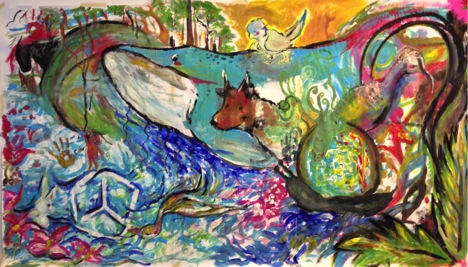
The ideas of the second group, Bringing Us Together, were so varied that they opted to have each participant create an individual piece for each theme of Peace, place and identity, brought together within a quilt format for visual unity. The group used a paper support and mixed media to create their mural. Every participant had a column of three squares in which to complete his or her respective imagery. To unify everyone’s images both physically and metaphorically, a string was applied to the mural. The dark coloured thread had no boundaries as it travelled within and around the squares. The ordered structure of the quilt was contrasted with the flowing organic movement of the thread, which also represented how people from different places and identities need to be joined together to create peace.
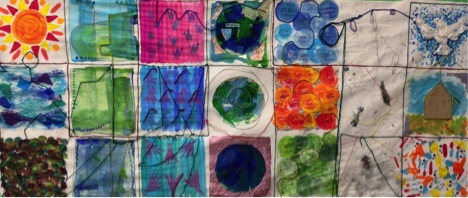
The third group, Growth, had a brainstorming session to search for ideas of how to represent their diverse identities. This was a peaceful negotiation of “That’s a good idea,” “ I don’t like this idea because…”, or “What do you think if we…”. This exchange of ideas was crucial to the success and enjoyment of creating their mural. This group used kraft paper, coloured chalk and acrylic paints. They worked together to create one image on which all the members agreed. This process was an exercise in listening and responding in a harmonious and respectful manner and made the time spent together enjoyable. The group opted to use the symbol of the tree to represent the three themes. Starting from the roots of the tree, each participant’s foot was outlined with her/his chosen coloured chalk. Each root was personalized to represent the individual. The journey of each student began at their distinct root and merged with one another in the trunk area, representing the university as a place of shared experience. Once their studies are completed, each member will leave this shared experience, the trunk, and branch off on their individual journeys.
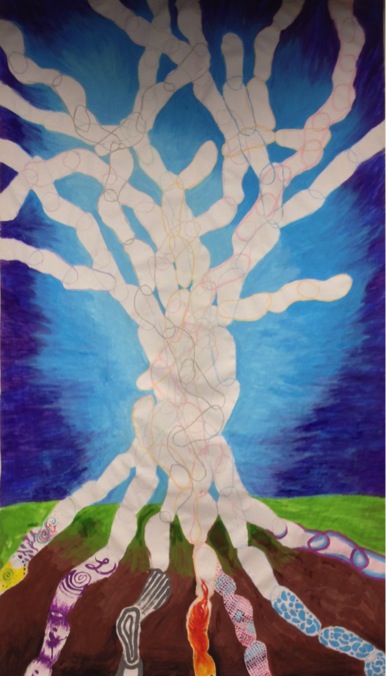
The collaborative mural activity was a very positive learning experience and provided information to guide these future teachers through similar endeavors. The murals acted as a creative exercise where one accepted and rejected ideas with respect. Through this process, we built on one another’s contributions and created a shared place and identity. As a result, stronger bonds were forged amongst classmates and reinforced an overall sense of community within the group.
References:
Anderson, T. & Milbrandt, M.K. (2005). Art for life: Authentic instruction in art. New York, NY: McGraw-Hill Companies, Inc.
Saraid Wilson
4th Year, Art Education Specialization
Interview with Lily Yeh
Each country, each city has “broken places” that have experienced financial ruin and unemployment. There, in these “broken places” are communities who need the work most and are grateful to have it, waving much of the imposing regulatory hoops to jump through.

Lily Yeh is one of the most prolific and inspiring figures in contemporary community arts. Born in China and raised in Taiwan, Yeh studied traditional Chinese painting before immigrating to Philadelphia, USA in 1963. After completing her master’s degree, Ms. Yeh began a thirty year career as a professor of painting and art history at Philadelphia’s University of the Arts. In 1986 Ms. Yeh’s community art career began when Arthur Hall, a dancer, choreographer and teacher involved in community building, asked her to transform a vacant lot beside the Afro-American Dance Ensemble’s studio building in North Philadelphia. In 1989, Ms. Yeh co‑founded the Philadelphia based organization The Village of Arts and Humanities. Under her direction, the organization would convert over one hundred and twenty lots into public community art parks, gardens and artist studios. In 2003, Ms. Yeh branched out on her own to found Barefoot Artists Inc., a non-profit organization that would take her community arts projects to an international level. Barefoot Artists Inc. has spearheaded community art interventions in Rwanda, Ghana, Palestine, Haiti, India, Ecuador and Syria, to name only a few. In 2009, Lily Yeh was the recipient of the Fleisher Art Memorial Founder’s Award for her dedication to community art. Her reverie and determination have been captured in a 2013 documentary film entitled The Barefoot Artist.
On February 27, 2014, I had the great fortune to sit down, one on one, with the legendary Lily Yeh while she was visiting Concordia University to give the keynote speech and a methodological workshop at the Art Education Graduate Symposium, “The Art of Transforming Communities.” Our conversation began with discussing her career move from a prestigious teaching position and gallery representation in Philadelphia to a community arts practice. Ms. Yeh explained that she has lived a life without want. Her parents had given her a lovely home to live in, food on the table and an education. Philadelphia has given her many opportunities, from working at the university to exhibiting in art galleries. She was grateful for her successes, but felt something was missing. When she began to work on the first art park project with Arthur Hall, she recalled knowing right away that this type of community building project through art was for her. Ms. Yeh states that at the time she remembers not even talking about it with her colleagues at the university. “Why would anyone go from the gallery to the inner city? It would have seemed so wild to them!” she reminisced.
At the time, she remarks, the prevailing idea was that no art of any value or quality could be produced in the community art setting. She recounts feeling unsure of what truly could be done, and if there was something to be achieved, she wasn’t sure if she could do it. Ms. Yeh recalls not knowing if the art park project would be possible at all and where would she find the required materials: “But then the money showed up and the whole thing became real.”
Our conversation moved to discussing the current state of communities in 21st century society. Noting the significant rise in urban property values that have pushed our lower and middle class citizens to the outskirts of urban centers and beyond; the destruction of industry cities like Detroit, rendering working families homeless; and the rapid gentrification of our urban neighborhoods and the erection of a ‘Starbucks culture’, I asked Ms. Yeh whether within these economic conditions, communities can still maintain a community voice, and if so, whether this voice can be heard over the rattle and hum of supposed progress.
Ms. Yeh responded that while you cannot fight the great tide of capitalism, you must be determined to have your voice heard, to make your life count. She makes clear that each one of us must take a stand and reveal an “authentic” point of view that is reflective of who we are and our own social circumstance. Ms. Yeh suggests that this process begins in small scale interactions that must be met with attentive and fervent listening and respect. It is in these everyday interactions that allow for voices not to be “dominated by the mainstream,” rather, to be heard. She believes that we are each responsible to make choices that reflect our values; for example, to use our purchasing power to support our communities. Ms. Yeh asserts that our individual voice carries great power of which we are seldom aware. She states that if we are to create change and adopt a common voice, we need to respect ourselves and each other, give value to our own individual voice as well as the voices around us, and claim our right to that common voice. “If we take ourselves seriously, our voice seriously, our actions manifests of our values. Our voices and actions together then can be heard. Our voices have great power. We can never give that away.”
We then discussed the modern notion of space and its implications for art parks. In the current real estate market, many developers target low-income neighbourhoods as, seizing inexpensive vacant lots that can be turned into large condominium projects, marketed as within trendy ‘up and coming’ neighborhoods. I asked Ms. Yeh about the differences and difficulties in acquiring these lots for the use of art parks today compared to when she began her work in community art beginning her practice. I asked her if the lots spaces that are being used by community art initiatives are in danger and if so, is there is a future for urban art parks at all?
“Space is always available; it is just about how you define that space,” Ms Yeh responded. She agrees that cities are becoming more and more expensive, however she insists you can still find space by changing your focus. Ms. Yeh describes how too often art activists look for transformable space in their own backyards when they should be following “the space” instead. She cites Detroit as an example, where you can now find all the space you want. Ms. Yeh claims that her own search for space brought her to this conclusion. She describes how all urban space is watched closely and observing parties bring with them a set of bureaucratic challenges that can be at odds with the free approach of grassroots community development projects. Ms. Yeh states, “I don’t want to ask for permission. I want to do what I need to do. I want to follow my passion and live my life.”
Lily Yeh believes that community artists and activists should be looking to the “broken places” for space. Each country, each city has broken places that have experienced financial ruin and unemployment. There, in these broken places, are communities that need the work most and are grateful to have it, and will often waive many of the imposing regulatory hoops to jump through. Ms. Yeh suggests that these broken places are the new frontier for art and social change. The derelict state of these broken places, the collapsed houses and cracked streets, represent our lack of foresight, vision, imagination and innovation; she avows that these broken spaces wait for those who are brave and can see past the rubble to the endless possibilities.
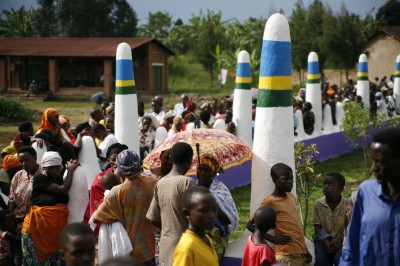
I wanted to know more about Barefoot Artists and where the organisation is headed. I asked Ms. Yeh about the future of the organisation and the volunteers she works with. How does she choose her protégés and how would a Concordia Art Education student get involved?
Lily Yeh attests that Barefoot Artists Inc. operates hand to mouth. When the organisation has funding, it can wield great change to desperate communities. However when the money runs out, the entire operation grinds to a halt. Ms. Yeh explains that the organisation itself is run completely by volunteers, herself included. Her eighteen years at the helm of The Village of Arts and Humanities brought with it a massive responsibility to manage the maintenance of the parks, the staff and the organisation itself. Part of her decision to leave and start Barefoot Artists Inc. was to get back to hands-on project management. The key to the success of the Barefoot Artists Inc. projects are the partnerships that she makes at the local level. Ms. Yeh states that each site has different needs and requires different types of leadership and direction. “Every project is different. I don’t go [to a community] with a system to put in place. I have to feel the land and the people.”
Ms. Yeh recounts the help she received from students of the University of Florida and Jefferson University, who participated as volunteers on two of her projects. “University students are so savvy,” says Ms. Yeh. “When the right students come in with their energy and their desire to change the world, beautiful things can happen.” I asked her if university students can contact Barefoot Artists Inc. and pitch a project? She replied yes, but that the circumstances need to be carefully examined. Ms. Yeh described how it can be problematic when university students take leadership roles that knowingly or unknowingly upstage the local citizens. Sensitization and training are required to ensure that the projects outlined by students do not become academic pursuits that overshadow the needs of the community. The underlying goal in any project is to empower the local community, so that when Barefoot Artists leave a site, the work continues guided by the community leaders and propelled the community’ own initiative.
Our conversation turned to considering the issue of funding and the implications of partnering with businesses. We discussed how it can be difficult to negotiate the amount of influence and exposure that corporations should have and will have on the community when grass roots organizations seek out financial support. I asked Ms. Yeh how to best approach a partnership with a business, without setting a tone for corporate culture within that community?
“It can be done,” responds Lily Yeh, confidently. Ms. Yeh outlines that when dealing with financial aid from those who could be influential, you must set boundaries from the beginning. Yeh believes that most corporations are interested in having a positive impact on their local communities and given the chance to rise to the occasion, they will. It is the channelling of their goodwill that needs to be mediated, says Ms. Yeh. The corporation must also respect the message of the project and not overshadow the members of that community. She emphasizes again, it is the community partners and their role in the project that are essential to this negotiation. When you have the ear of that community and can truly understand their specific needs, only then can you act in their best interest. Keeping the community leaders involved is the best way to make certain that the focus of the project remains on course.
To close our discussion, I asked Ms. Yeh about the documentary on her work entitled The Barefoot Artist, a film co-directed by Glenn Holsten and her son Daniel Traub. I asked her whether she ever envisioned herself becoming a film star. Ms. Yeh said she had never considered making a documentary, although Glenn Holsten had filmed her work at The Village of Arts and Humanities in its early stages for a local Philadelphia PBS station. (Holsten’s filming of Yeh’s work continued over the years and become a one hour documentary on the North Philadelphia projects, released over a decade ago.) When she began working under Barefoot Artists Inc., her son Daniel would travel with her. “He would do me the favour of filming what was happening,” says Ms. Yeh.
Lily Yeh recounts that film came about when she decided to mend the “broken places” in her own life. Divorcing his first wife to marry Lily’s mother, her father had two families, fathering children with two women. After her father’s death, Lily Yeh wished to bridge the gap between the now middle-aged and elderly children of the two families. Holsten asked to film this process. Through these periods of filming, Traub interned with Holsten, becoming a filmmaker in his own right. “Glenn had my family story and Daniel had the stories of my work, so the two of them came together.” says Ms. Yeh. She told me that at first she felt like the two stories would be difficult to overlap. Then she realised that both stories have a common thread: both are about repairing brokenness. “Without realising it, without knowing it, I was drawn to broken places, because of the brokenness in my own family.”
“Broken places are my canvases. Peoples’ stories are my colors. Together we shape something that belongs to nobody and to everyone. That is Barefoot Artists. That is my work.”
Lily Yeh is in her seventies, but projects an energy that can only be described as youthful. Her laughter and joie de vivre make it easy to understand why she has been welcomed into so many lives and communities. Her passionate community arts practice is a global presence of goodwill, proving that with a little paint and a lot of heart, real social change is not only possible but very attainable. If I had to take away only one thing from our conversation it would be that one individual can make a profound difference. That change is possible if we respect our voice and the voices of our communities.
Profound thanks to Lily Yeh, for this candid conversation about art, community, family and the possibilities for a better world.
For further information about Lily Yeh and her work:
Carolyn Weisnagel
4th Year, Art Education Specialization
Projected Migrations
Video
6 min.
2013
As a non-aboriginal artist and art educator, working within a framework of socially engaged art practice, my intent is to pay tribute to human experience and the resilience of displaced or marginalized peoples. Through issues-based pedagogy, I hope to evoke the potential in my students to imagine change through their own agency and critically reflect on issues that affect the health of communities and environments.
Projected Migrations aims to expose the unjust displacement of aboriginal communities, specifically Attawapiskat First Nation in northern Ontario. This community, and others across the country, live in despair due to the social arrangements established by our government. My project aims to acknowledge our system’s failure as non-indigenous and Eurocentric interventions continue to erode northern living conditions.
In November 2013, news broke of residents and families located at the mouth of the Attawapiskat River at James Bay that they were again being evacuated from their remote First Nations community due to substandard living conditions. This crisis inspired me to create a work which reframed romanticized notions of nature in the Canadian North. Projected Migrations is a three-dimensional projection of videos onto a man-made storage shed in my backyard woods.
Inspired by the strength and perseverance of Attawapiskat residents to exist in deplorable conditions brought about by the politics of “historical colonialism and its ideology of denial” (Watkins & Shulman, 2008, p.30), I situated viewers as witnesses to the “greatest natural migration on earth” of our Canadian caribou herd, intercut with images of the ongoing community crisis occurring in the Attawapiskat First Nation. As I worked on the video, I became more conscious that, as a privileged immigrant (Battiste, 2000, p. 196), I needed to be mindful of the ethical challenges of appropriating the conditions and pain of Canada’s indigenous peoples. I felt strongly the demand for personal accountability in representing their knowledge and traditional practices of a world that operates according to a rhythm completely different from the one to which we are accustomed. (Miller & Sheehy, 2008, p.103) In this spirit, I implicitly challenge my audience to reconcile and contest the exclusionary interests of government and business interventions, which break the balance of communities and nature.
References
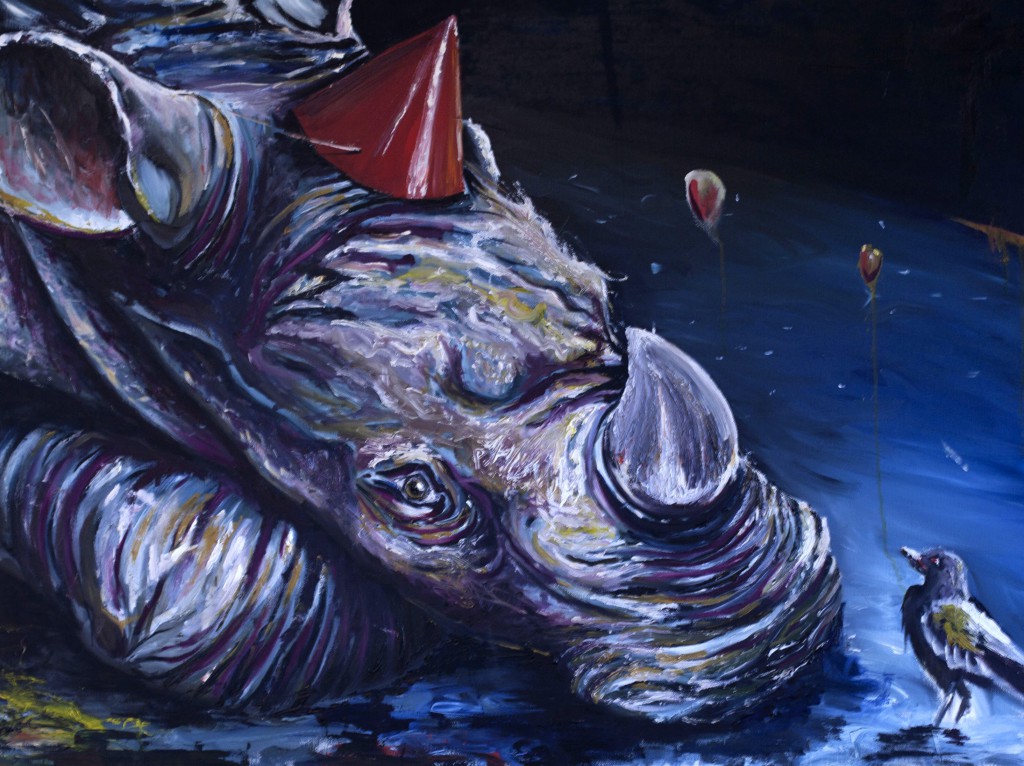
Thibault Zimmer
3rd Year, Art Education Major
Cohesions
oil paint on canvas
22” x 48”
2012
Cohesions presents two contrasting characters: a rhinoceros and a bird. Within this composition, their depiction highlights the differences in their size and strength. However, the unexpected eye contact between the two creatures reveals their powerful bond. In this particular context, the relationship between the two animals reflects the profound connections that are formed between a teacher and a student.
This work examines the importance of dialogue within community contexts. Art is a powerful tool within these settings, and in many instances, acts as a language; redefining the boundaries of another. As an art educator, I highly value the power of communication and believe that we must engage our students through effective dialogue, whether it is visual or verbal. Through meaningful learning, we invite students to become active members of our community, using art as a vehicle for expression, creativity and personal growth.

Alexe Harnois
4th Year, Art Education Major
Transformations
digital drawing
2 panels each 8.5” x 11”
2014
Transformations is a reflective investigation of the transformative capacities of community-based art initiatives. As key members to these contexts, art educators play a fundamental role in forming and shaping communities. Art educators thus have the potential to initiate positive change and promote constructive evolution in today’s society.Consisting of two panels, Transformations duplicates and reflects a single image to accentuate the importance of different views and interpretations. Using line and pattern, this work compares the nature of communities to the art of weaving. It is through the combination of intricate and interconnected elements that these contexts are formed. To bring life to the pattern, a hand is depicted pulling at segment of the weaving, altering its previous state and transforming the rigid structure of the line.

En Masse and undergraduate students in Art Education
Untitled
India ink, marker and acrylic paint on paper
5′ x 25′
2014
In collaboration with the artists’ collective En Masse Pour Les Masses, students in the undergraduate course Multi-Disciplinary Approaches to Art and Teaching created a mural during a three hour workshop. The goal of this experiential art making activity was to offer students tools and strategies for to creating an original collaborative mural.
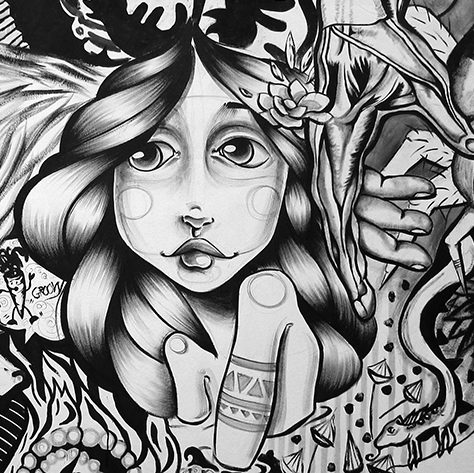
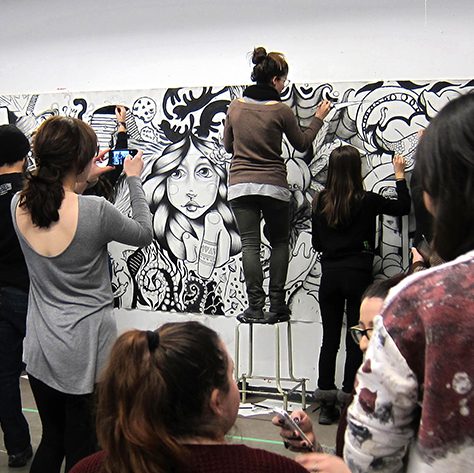
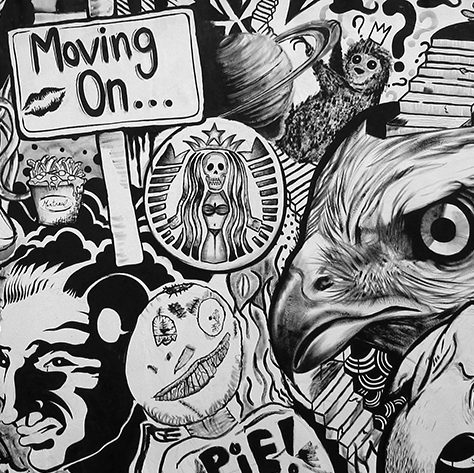
The opportunity to collaborate with En Masse was an invaluable experience for everyone involved. The ability to create such as large mural in the context of a workshop is a potent gentle reminder of the power of collaboration in the art making process.
We would like to thank the En Masse artists Katie Green, Dave Todaro, MC Baldassari, Jason Bolkin, Sebastian Botkin for animating this workshop. More information on their work can be found at http://emplm.org/. We would also like to thank the many participating art education students.